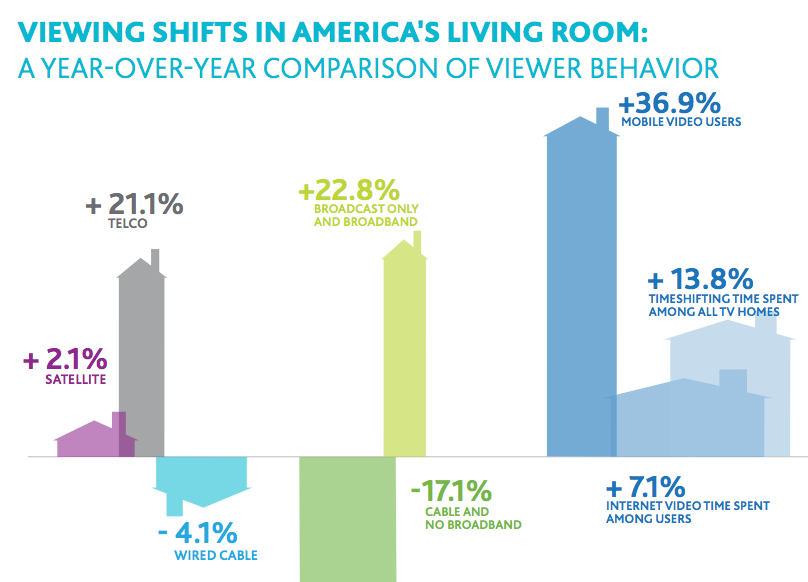If you've been paying attention to the evolving media landscape, changing audience behaviors, and debates over measuring viewing (or listening, reading, etc.), you knew this was coming.
According to press reports, Nielsen's been telling it's clients that it's changing its definition of TV. Since it's beginning, the Nielsen ratings universe has been based on TVHH - households with a working TV set, and measured viewing as occurring on TV sets. Certainly definitions that made sense when the only way to watch TV programming (and ads) was through a television set tuned to a broadcast. The definitions endured through the rise of cable (and DBS), VCRs, DVDs, etc. While greatly expanding viewing options, you still needed the TV set as the display.
The digital revolution started changing that - you could connect TV tuners to computers and watch on the computer's display; TV content went online, and broadband diffusion made high quality streaming viable; DVRs fulfilled the VCR's promise of time-shifting, and mobile looks to fulfill the promise of place-shifting. Time-shifting increased to the point where Nielsen and the networks had to find a way to count that audience, and continued growth of time-shifting ignited the current debates over what time period gets added in to the live viewing. Still, however, the feeling was that the key component of TV was the larger TV screen - and that remained the foundational definition.
For now, the TV set remains the foundation, but Nielsen will start looking at internet-connected TVs and viewing via internet streaming. Nielsen's basic shift is that they will start including internet-only TV households in its sample, and start tracking viewing via streaming. At this point, the proportion of (zero TV profile) households - those that don't watch TV over traditional (terrestrial broadcast, multichannel bundlers) channels - is small, but growing. Nielsen estimates that when the new sample ratings kick in this coming fall (2013), the impact will initially be small (around half a ratings point), but as the "zero TV" segment grows, Nielsen wanted to be in a position to capture shifting behaviors.
For advertisers concerned that these new delivery systems aren't carrying the original broadcast commercials - inflating the numbers reached and their costs - Nielsen indicated that, for now, the extra viewing will be captured separately, and specifically won't be included in the C3 ratings that form the basic currency in network/advertising rate-setting. (C3 counts live viewing plus time-shifted viewing within three days).
The move should be welcomed as a step in coming to grips with the shifting media-audience ecosystem. And help foster recognition of shifting media usage patterns, and the need to distinguish between viewing of content and viewing of ads. It's been apparent that DVRs and new distribution channels have made it difficult to sustain the assumption that viewing a program equates with viewing the ad. That's always been a questionable assumption, but now, viewing on other channels, through VOD, through streaming - all of which don't necessarily carry the same set of embedded advertising - is at the point where advertisers are pushing back at the networks and Nielsen. This latest move should help solidify the distinction, and push for multiple metrics to met various needs.
Still, there's a potentially bigger evolutionary force out there - the impact of mobile and the facilitation of place-shifting. This move doesn't address that issue - the metrics still focus on content consumed on the TV set. According to Brian Fuhrer, senior vice president-national & cross-platform product leader at Nielsen, wireless broadband is enabling new viewing alternatives - smartphones, tablets, even wireless gadgets connected to TVs. Nielsen's looking at that, and how that would further redefine "TV." I'd like to see that come quickly, but dealing with how to best measure and greatly expanded set of viewing options, as well as the continuing explosion in available "TV" content, poses a number of issues that will need to be resolved. Nielsen indicates it's working towards that, as are a number of Internet-metrics players. It'll be an interesting race - and one that shouldn't necessarily go to the quickest, the biggest, or the traditional dominant force. Getting it right is critical to get a true reflection of changing patterns.
Source - Nielsen Redefines 'Television,' Will Include Internet-Only Connected Sets, Households, MediaDail News
America's Living room: More Internet, less wired cable, VatorNews (older story, source of graphics)


Connect Play mi arıyorsunuz? Tıklayın: Connect Play
ReplyDelete